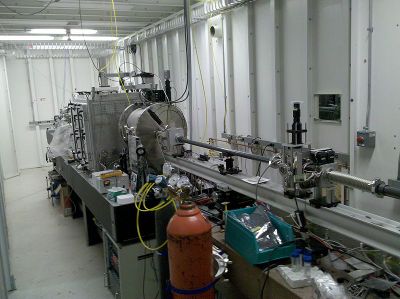Difference between revisions of "X9"
KevinYager (talk | contribs) |
KevinYager (talk | contribs) (→Performance) |
||
| Line 18: | Line 18: | ||
* '''1.5 m''': 0.011 Å<sup>−1</sup> to 0.45 Å<sup>−1</sup> (63 nm to 1.4 nm) | * '''1.5 m''': 0.011 Å<sup>−1</sup> to 0.45 Å<sup>−1</sup> (63 nm to 1.4 nm) | ||
| − | For WAXS, | + | For WAXS, standard configurations yields approximately (for 13.5 keV): |
* '''0.235 m''' (sample inside chamber): 0.13 Å<sup>−1</sup> to 4.1 Å<sup>−1</sup> (4.8 nm to 0.15 nm) | * '''0.235 m''' (sample inside chamber): 0.13 Å<sup>−1</sup> to 4.1 Å<sup>−1</sup> (4.8 nm to 0.15 nm) | ||
* '''~0.4 m''' (sample upstream of chamber): 0.15 Å<sup>−1</sup> to 2.1 Å<sup>−1</sup> (4.2 nm to 0.3 nm) | * '''~0.4 m''' (sample upstream of chamber): 0.15 Å<sup>−1</sup> to 2.1 Å<sup>−1</sup> (4.2 nm to 0.3 nm) | ||
| + | |||
| + | |||
| + | ===Flux=== | ||
| + | * At 10 keV, flux capture by mirrors is ~2×10<sup>12</sup> ph/s/0.01%bw | ||
| + | * At 10 keV, flux at sample is ~5×10<sup>11</sup> ph/s/0.01%bw | ||
| + | * At 10 keV, microfocused (10 um), flux at sample is ~2×10<sup>11</sup> ph/s/0.01%bw | ||
==Safety== | ==Safety== | ||
Users must complete [http://www.bnl.gov/ps/nsls/users/access/training.asp NSLS safety training], as well as receive beamline-specific training: | Users must complete [http://www.bnl.gov/ps/nsls/users/access/training.asp NSLS safety training], as well as receive beamline-specific training: | ||
* [http://beamlines.ps.bnl.gov/forms/BLOSA/X9.pdf X9 BLOSA form] | * [http://beamlines.ps.bnl.gov/forms/BLOSA/X9.pdf X9 BLOSA form] | ||
Revision as of 15:57, 3 June 2014
X9 is an x-ray synchrotron beamline at the National Synchrotron Light Source (NSLS), Brookhaven National Lab (BNL). It is a joint beamline between the NSLS and the Center for Functional Nanomaterials. The instrument is optimized for doing Small-Angle X-ray Scattering (SAXS) and Grazing-Incidence Small-Angle X-ray Scattering (GISAXS), as well as wide-angle Grazing-Incidence X-ray Diffraction (GID/GIXD/GIWAXS).
Capabilities
TBD
Performance
Energy range
Can perform experiments from 6 keV to 20 keV.
q-range
The instrument can capture data on both a SAXS and WAXS detector (either simultaneously or sequentially). The q-range depends on x-ray energy and the sample-detector distance. For SAXS, one can typically obtain (e.g. for 13.5 keV):
- 5.4 m: 0.002 Å−1 to 0.1 Å−1 (314 nm to 6.3 nm)
- 4.1 m: 0.005 Å−1 to 0.2 Å−1 (125 nm to 3.5 nm)
- 3.0 m: 0.004 Å−1 to 0.2 Å−1 (157 nm to 3.5 nm)
- 2.0 m: 0.010 Å−1 to 0.4 Å−1 (63 nm to 1.6 nm)
- 1.5 m: 0.011 Å−1 to 0.45 Å−1 (63 nm to 1.4 nm)
For WAXS, standard configurations yields approximately (for 13.5 keV):
- 0.235 m (sample inside chamber): 0.13 Å−1 to 4.1 Å−1 (4.8 nm to 0.15 nm)
- ~0.4 m (sample upstream of chamber): 0.15 Å−1 to 2.1 Å−1 (4.2 nm to 0.3 nm)
Flux
- At 10 keV, flux capture by mirrors is ~2×1012 ph/s/0.01%bw
- At 10 keV, flux at sample is ~5×1011 ph/s/0.01%bw
- At 10 keV, microfocused (10 um), flux at sample is ~2×1011 ph/s/0.01%bw
Safety
Users must complete NSLS safety training, as well as receive beamline-specific training:

